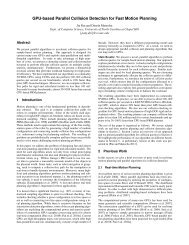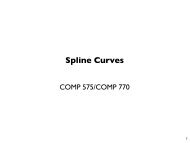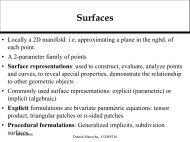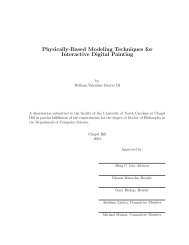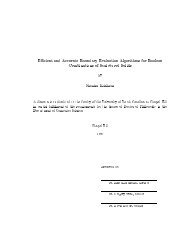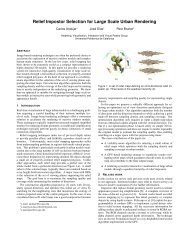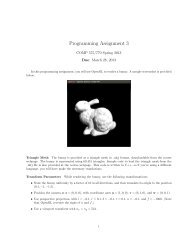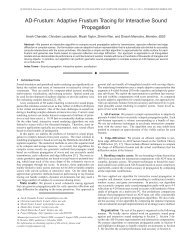Paper - Geometric Algorithms for Modeling, Motion, and Animation ...
Paper - Geometric Algorithms for Modeling, Motion, and Animation ...
Paper - Geometric Algorithms for Modeling, Motion, and Animation ...
Create successful ePaper yourself
Turn your PDF publications into a flip-book with our unique Google optimized e-Paper software.
a0<br />
a1<br />
P0<br />
n1<br />
T0<br />
T1<br />
P<br />
t<br />
b0<br />
Tt<br />
b1<br />
n0<br />
P1<br />
nt<br />
c1<br />
c0<br />
(a) De<strong>for</strong>ming triangle ( T)<br />
&<br />
de<strong>for</strong>ming vertex ( P)<br />
at<br />
Pt<br />
( P a ) n<br />
t<br />
t<br />
nt<br />
(b) Projected distance<br />
between Pt <strong>and</strong> t T<br />
Figure3:VFtestfilter:Toper<strong>for</strong>maVFtestbetweenade<strong>for</strong>ming<br />
triangle(definedby a0, b0, c0at t = 0,<strong>and</strong> a1, b1, c1at t = 1)<br />
<strong>and</strong>amovingvertex(definedby P0at t = 0<strong>and</strong> P1at t = 1),we<br />
needtocheck<strong>for</strong>coplanaritybetweenthevertex<strong>and</strong>thetriangleby<br />
findingat(t ∈ [0, 1])whentheprojecteddistancealongthenormal<br />
vectorofthetriangleisequaltozero,i.e., (Pt − at) · nt = 0.<br />
servative<strong>for</strong>primitivelevelCCDtests.Fortheexampleshownin<br />
Fig.2, BV (T)<strong>and</strong> BV (P)aretheboundingvolumesofade<strong>for</strong>mingtriangle<br />
T <strong>and</strong>ade<strong>for</strong>mingvertex P,respectively. Inorder<br />
toper<strong>for</strong>mculling, BV (T)<strong>and</strong> BV (P)mustcontaintheswept<br />
volumesofde<strong>for</strong>mingprimitives,i.e., SV (T)<strong>and</strong> SV (P),respectively(Fig.2(a-b)).<br />
TheVFpair {T, P }willbetested<strong>for</strong>exact<br />
CCDtest,sincetheirboundingvolumesoverlapduringthetime<br />
interval [0, 1](Fig.2(c)).<br />
Wemakeuseofthefollowingobservation:ifthevertex Pisalways<br />
onthesamesideofthetriangle Talongtheentire [0, 1]trajectory,<br />
thispairshouldbeclassifiedasafalsepositivesinceitcannotbe<br />
coplanar(Fig.2(d)).Basedonthisobservation,wederiveasufficientconditiontocheckwhether<br />
Ptwillalwaysbeonthesameside<br />
of Ttduringthetimeinterval [0, 1].Ifapairofprimitivessatisfies<br />
thiscondition,thenwedon’tneedtoper<strong>for</strong>mtheexacttestinterms<br />
ofsolvingacubicequation.<br />
Theideacanbesimilarlyextended<strong>for</strong>theEEtests:ifthereisno<br />
crossingbetweenthetwode<strong>for</strong>mingedgesalongthecontinuous<br />
trajectory,theycannotbecoplanarduringthetimeinterval.<br />
3.3 CoplanarityTest<br />
Inordertocheckthecoplanarityofavertex Pt<strong>and</strong>atriangle Tt,<br />
weneedtocalculatetheprojecteddistancebetweenthemalongthe<br />
directionof nt,asshowninFig.3(b).Ifthisdistancebecomeszero<br />
atanytimeinterval,thanthefourverticesofthetwoprimitivesare<br />
classifiedascoplanar.<br />
Non-coplanarTheorem<strong>for</strong>VFtests: Foratriangle Tt<strong>and</strong>a<br />
vertex Ptdefinedbythestart<strong>and</strong>endpositionsduringtheinterval<br />
[0, 1],thesepositionsarelinearlyinterpolatedintheintervalwith<br />
respecttothetimevariable, t.Ifthefollowingfourscalarvalues:<br />
A, B, 2∗C+F<br />
,<strong>and</strong> 3 2∗D+E<br />
havethesamesign, Tt<strong>and</strong> Ptwillnot<br />
3<br />
becoplanarduringtheinterval:<br />
A = (P0 − a0) · n0, B = (P1 − a1) · n1 (1)<br />
C = (P0 − a0) · ˆn, D = (P1 − a1) · ˆn (2)<br />
E = (P0 − a0) · n1, F = (P1 − a1) · n0 (3)<br />
t<br />
And:<br />
n0 = (b0 − a0) × (c0 − a0), n1 = (b1 − a1) × (c1 − a1)<br />
ˆn = (n0 + n1 − (vb − va) × (vc − va))<br />
2<br />
va = a1 − a0, vb = b1 − b0, vc = c1 − c0.<br />
Proof. Thenormalvector ntofthede<strong>for</strong>mingtriangleattime tcan<br />
berepresentedasfollowing:<br />
nt = n0 ∗ B 2 0(t) + ˆn ∗ B 2 1(t) + n1 ∗ B 2 2(t) (4)<br />
where B 2 i (t)isthe i th basisfunctionoftheBernsteinpolynomials<br />
ofdegree 2.<br />
Wedefine: α = B 2 0(t) = (1 − t) 2 , β = B 2 1(t) = 2 ∗ t ∗ (1 − t),<br />
<strong>and</strong> γ = B 2 1(t) = t 2 .ThenEquation(4)becomes:<br />
nt = n0 ∗ α + ˆn ∗ β + n1 ∗ γ<br />
Forthemovingvertex Pt = P0 ∗ (1 − t) + P1 ∗ t<strong>and</strong>avertexof<br />
thede<strong>for</strong>mingtriangle at = a0 ∗ (1 − t) + a1 ∗ t,theirprojected<br />
distantalong ntis:<br />
(Pt − at) · nt = ((P0 − a0) ∗ (1 − t) + (P1 − a1) ∗ t) · nt<br />
= ((P0 − a0) ∗ (1 − t) + (P1 − a1) ∗ t)<br />
·(n0 ∗ α + ˆn ∗ β + n1 ∗ γ)<br />
= (P0 − a0) · n0 ∗ (1 − t) ∗ α<br />
+ (P0 − a0) · ˆn ∗ (1 − t) ∗ β<br />
+ (P0 − a0) · n1 ∗ (1 − t) ∗ γ<br />
+ (P1 − a1) · n1 ∗ t ∗ γ<br />
+ (P1 − a1) · ˆn ∗ t ∗ β<br />
+ (P1 − a1) · n0 ∗ t ∗ α<br />
Substitute α, β,<strong>and</strong> γ,wehave:<br />
(Pt − at) · nt = (P0 − a0) · n0 ∗ (1 − t) 3<br />
+ (P0 − a0) · ˆn ∗ 2 ∗ (1 − t) 2 ∗ t<br />
+ (P0 − a0) · n1 ∗ (1 − t) ∗ t 2<br />
+ (P1 − a1) · n1 ∗ t 3<br />
+ (P1 − a1) · ˆn ∗ 2 ∗ t 2 ∗ (1 − t)<br />
+ (P1 − a1) · n0 ∗ t ∗ (1 − t) 2<br />
UsingthesymbolsdefinedbyEquations(1)-(3),Equation(5)becomes:<br />
(Pt − at) · nt = A ∗ (1 − t) 3 + C ∗ 2 ∗ (1 − t) 2 ∗ t<br />
+ E ∗ (1 − t) ∗ t 2 + B ∗ t 3<br />
+ D ∗ 2 ∗ t 2 ∗ (1 − t) + F ∗ t ∗ (1 − t) 2<br />
= A ∗ B 3 0(t) +<br />
+ 2 ∗ D + E<br />
3<br />
2 ∗ C + F<br />
3<br />
∗ B 3 1(t)<br />
(5)<br />
∗ B 3 2(t) + B ∗ B 3 3(t) (6)<br />
where B 3 i (t)isthe i th basisfunctionoftheBernsteinpolynomials<br />
ofdegree 3.<br />
Byusingtheconvexhullpropertyassociatedwithcontrolpointsof<br />
theBernsteinbasis,therangeoftheprojecteddistancebetween Pt<br />
<strong>and</strong> Ttisboundedbythecontrolvertices.Inourcase,thesecontrol<br />
verticesarethefourscalarvalues: A, B, 2∗C+F<br />
3 ,<strong>and</strong> 2∗D+E<br />
3 .






